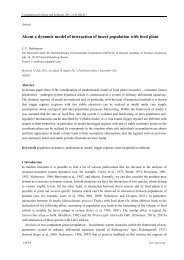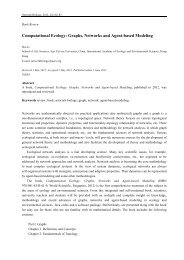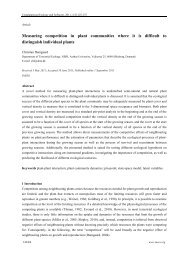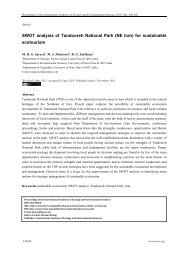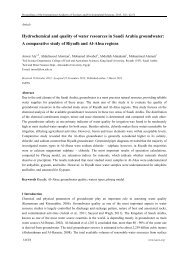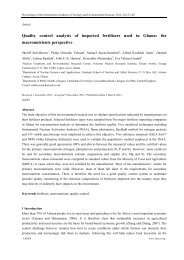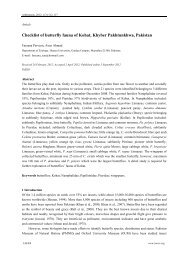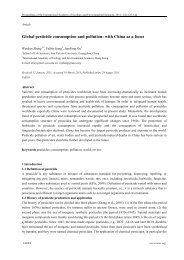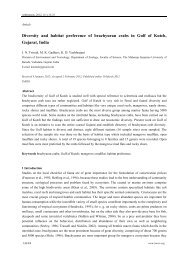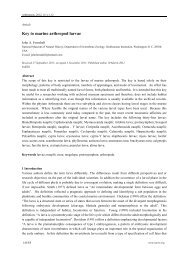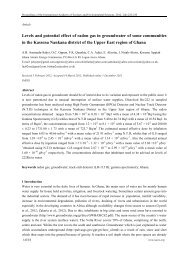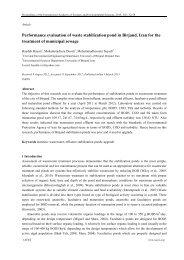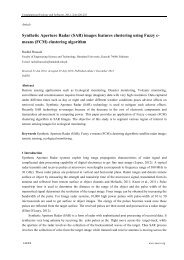Invasion ecology: Origin and biodiversity effects - JournalTOCs
Invasion ecology: Origin and biodiversity effects - JournalTOCs
Invasion ecology: Origin and biodiversity effects - JournalTOCs
You also want an ePaper? Increase the reach of your titles
YUMPU automatically turns print PDFs into web optimized ePapers that Google loves.
Environmental Skeptics <strong>and</strong> Critics, 2013, 2(3): 73-81<br />
75<br />
literature (Davis et al., 2001). By 1958, Elton was already a famous ecologist best known for his books on<br />
animal <strong>ecology</strong> <strong>and</strong> the dynamics of animal populations. So why, in his later years, did Elton suddenly make<br />
the distinction between invasion <strong>and</strong> succession <strong>ecology</strong>? During World War II in Great Britain, Elton was<br />
asked to find better ways to control the rabbits, house mice <strong>and</strong> rats in order to protect the human food supply<br />
(Davis et al., 2001). All of these species were supposed to have originally invaded from Europe <strong>and</strong>, at the<br />
time, the country was under the threat of invasion from Germany. So, in order to emphasize the destruction<br />
caused by those pests, they were called invaders with a militaristic connotation. Elton’s (1958) book focused<br />
almost entirely on notorious invaders of various kinds.<br />
More recently, invasion <strong>ecology</strong> has benefited from advances on other fronts. Williamson (1996) published<br />
a textbook on biological invasions intended for both students <strong>and</strong> professionals. This work covers the main<br />
aspects of the subject with appropriate examples. The emphasis is on invaders as pest species, but this simply<br />
reflects the majority of published literature. Another major publication is the book Species <strong>Invasion</strong>s (Sax et al.,<br />
2005). More recently, several other books dealing primarily with invasions, have been published. A review of<br />
ecological <strong>and</strong> evolutionary insights provided by invasions has been published (Sax et al., 2007). All of these<br />
books <strong>and</strong> the indicated review represent a small part of the enormous increase in publications on invasion<br />
biology that has taken place within the past 20 years. In retrospect, our present knowledge about species<br />
invasions represents an accumulation from continued isl<strong>and</strong> studies <strong>and</strong> the post-1958 revival of interest in the<br />
subject.<br />
Along with the general increase of interest in invasions, marine invasive organisms became an important<br />
research focus, <strong>and</strong> a noticeable dichotomy developed between the fields of marine <strong>and</strong> terrestrial invasion<br />
<strong>ecology</strong>. Most of the early marine work was concerned with the damage inflicted by pest species introduced by<br />
ships into harbors <strong>and</strong> estuaries (Briggs, 2012). Despite the fact that modern invasion research in both<br />
environments has become devoted to much the same questions (influences of species diversity, disturbance,<br />
vectors, propagule pressure, competition, etc.), the results tend to be reported in different journals with very<br />
little cross-referencing. Therefore, it has become important to examine both fields to see if advances in one<br />
might be applicable to the other.<br />
4 Marine <strong>Invasion</strong>s<br />
Some ecologists have identified exotic invaders as major threats to marine <strong>biodiversity</strong> despite scant evidence<br />
that <strong>biodiversity</strong> (here meaning species diversity or richness) is really being decreased. Molnar et al. (2008)<br />
used the Pacific oyster, Crassostrea gigas, as a prime example of a threat species. But this bivalve, although<br />
undesired in some places, cannot be conceived of as a threat to <strong>biodiversity</strong>. In northern Patagonia, it increased<br />
the population densities of epifaunal <strong>and</strong> infaunal organisms <strong>and</strong> also the feeding rates of bird species (Escapa<br />
et al., 2004). In the Wadden Sea, Crassostrea has partially replaced the native Mytilus <strong>and</strong> the community<br />
associated with the oysters showed superior species richness, abundance, <strong>and</strong> biomass (Reise et al., 2005). The<br />
Pacific oyster is an engineer species that enhances species diversity rather than being a threat, <strong>and</strong> there are<br />
other invader species that belong in the same category (Schlaepfer et al., 2011).<br />
The majority of successful marine invasions, known to involve reactions by native species, appear to<br />
consist mainly of alterations in abundance or shifts in habitat (Briggs, 2010). The latter is sometimes described<br />
as niche sharing or niche compression. But in most cases, it is not clear that niche alteration is involved. As<br />
will be noted in this paper, several terms describing the relationships between invaders <strong>and</strong> native species have<br />
been proposed. Most of the interspecies reactions have been reported by observers from the Mediterranean or<br />
the Wadden Sea. Although hundreds of marine invasions have been reported worldwide, mainly from harbors<br />
or estuaries, the details of the process by which invaders are accepted into native ecosystems remain<br />
IAEES<br />
www.iaees.org



